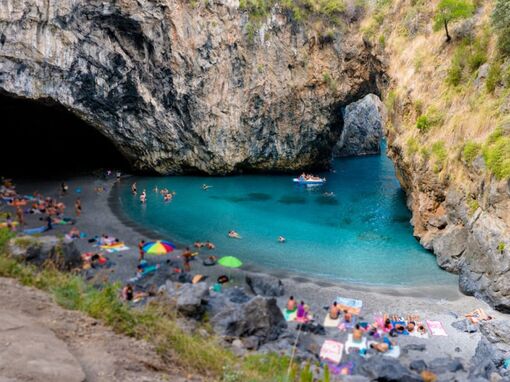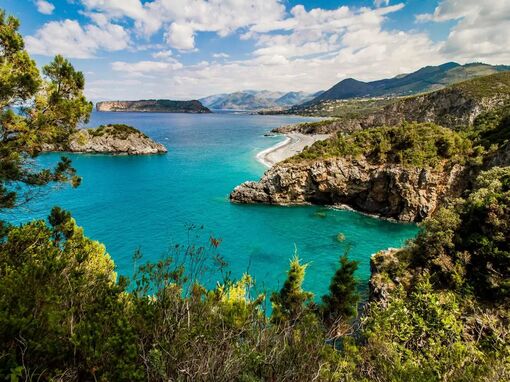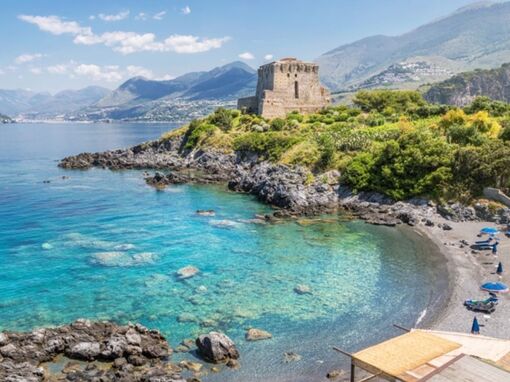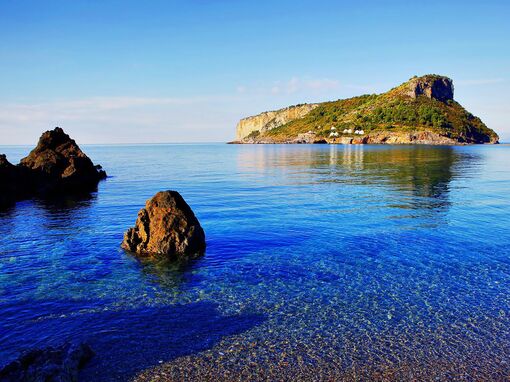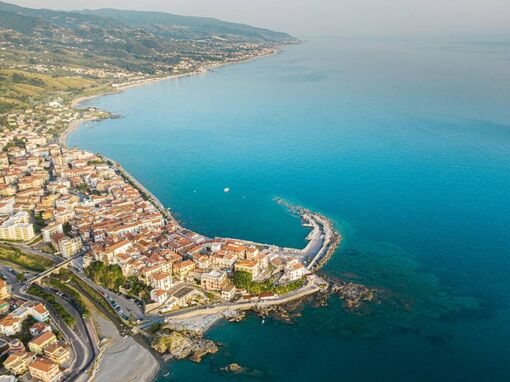
Ilze & Federico

Ilze & Federico
Il nome, "Riviera dei Cedri", è tutto un programma. Evoca profumo di zagara e il giallo dorato di un frutto baciato dal sole, che su questo tratto di Alto Tirreno cosentino regala splendidi tramonti.
Qui trova il suo habitat ideale il pregiato Cedro di Calabria DOP, un agrume autoctono dalle caratteristiche uniche: buccia liscia e lucente, grandi dimensioni, fioritura autunnale, utilizzato in pasticceria e nella cosmesi. Grazie alla presenza di questo frutto, la Riviera dei Cedri ospita ogni anno i rabbini di tutto il mondo, che arrivano qui per scegliere i frutti migliori per la festa ebraica del Sukkot (o Festa delle Capanne), che prevede l’utilizzo dell’etrog (il cedro) nella sua variante più pregiata.
La Riviera dei Cedri (o Costa dei Cedri) è rinomata per le sue spiagge, dalle quali raggiungere le due isolette calabresi: l'Isola Dino (Praia a Mare) e l'isola di Cirella (Diamante), due veri paradisi naturalistici e parte integrante del Parco Marino Regionale "Riviera dei Cedri".
Cetraro
Cetraro è un borgo agricolo-commerciale abbarbicato su uno sperone roccioso da cui si gode uno splendido panorama della costa. Cetraro fu probabilmente la prima città marittima bruzia e la sua Marina, con il porto turistico e le strutture ricettive distribuite sul litorale, è una delle più affascinanti località della Riviera dei Cedri.
Ed è proprio dal cedro che deriva il suo nome (Citrarium), che richiama la coltivazione dell’agrume molto diffusa nella zona.
Il borgo antico, arroccato su un colle, fu distrutto dai corsari nel 1534 e gravemente danneggiato dai numerosi terremoti sia nel 1638 che nel 1905.bCetraro fu probabilmente la prima città marittima bruzia e la sua marina, con il porto turistico e le strutture ricettive, è una delle più affascinanti località della Riviera dei Cedri. Il centro storico si snoda tra viuzze, archi e suggestivi scorci e l'accesso alla città avviene attraverso tre antiche porte: Porta di Mare, di Basso e di Sopra, testimonianze monumentali di un borgo anticamente fortificato.
Diamante
Arte, gastronomia e spiagge? Diamante, la "Città dei Murales e del Peperoncino" in provincia di Cosenza, lungo la splendida Riviera dei Cedri, è la località balneare che unisce al meglio questi tre elementi.
Il motivo è semplice: Diamante, mare (Calabria) da Bandiera Blu, è tra i paesi costieri che vanta uno dei primi centri storici vivacizzati dai murales (oltre 200, a partire dagli anni '80). Com'è noto, Diamante è anche la capitale del Peperoncino Calabrese, cui ogni anno dedica l'attesissimo Peperoncino Festival, nonché sede dell'Accademia Italiana del Peperoncino.
Cirella
Cirella, anticamente Cerillae, è una località del Comune di Diamante, in provincia di Cosenza, lungo la costa tirrenica che ricade nel Parco Marino Regionale "Riviera dei Cedri".
Importante porto antico ai tempi della Magna Grecia e di Roma, Cerillae, oggi Cirella, conserva i resti dell'originario borgo medievale presso il sito archeologico dei Ruderi di Cirella, che include anche il moderno Teatro dei Ruderi, sede di importanti festival e rassegne estive. L'altro simbolo della località balneare è l'omonima isoletta, l'Isola di Cirella, la più piccola tra le due isole calabresi (dopo l'Isola di Dino).
L’antica Cerillae fu distrutta dalla flotta napoleonica all’inizio dell'Ottocento. Dell'abitato si conservano pochi frammenti, tra i quali un affresco raffigurante la Madonna degli Angeli (oggi esposto nella chiesa parrocchiale). Poco distante dalla zona dei ruderi si trovano il Convento di San Francesco e il moderno teatro.
L'Isola di Cirella, poco al largo, rappresenta un prezioso ecosistema naturale. Raggiungibile in barca, è costituita da un affioramento di roccia calcarea coperto da macchia mediterranea. La parte sommitale della collina è occupata dai resti di un'antica struttura di avvistamento, la Torre dell'Isola di Cirella (IX secolo).
Tutto attorno si aprono grotte marine da esplorare, insenature e scogliere che sprofondano in uno specchio di mare cristallino, uno dei posti migliori dove fare immersioni in Calabria e habitat ideale della preziosa Posidonia Oceanica ed esemplari di Pinna Nobilis, il più grande bivalve del Mediterraneo.
The name, "Riviera dei Cedri", says it all. It evokes the scent of orange blossoms and the golden yellow of a fruit kissed by the sun, which on this stretch of the Alto Tirreno Cosentino offers splendid sunsets.
Here the prized Cedro di Calabria DOP finds its ideal habitat, a native citrus fruit with unique characteristics: smooth and shiny peel, large size, autumn flowering, used in pastry making and cosmetics. Thanks to the presence of this fruit, the Riviera dei Cedri hosts rabbis from all over the world every year, who come here to choose the best fruits for the Jewish holiday of Sukkot (or Feast of Tabernacles), which includes the use of the etrog (the citron) in its most prized variant.
The Riviera dei Cedri (or Costa dei Cedri) is renowned for its beaches, from which you can reach the two Calabrian islands: Dino Island (Praia a Mare) and Cirella Island (Diamante), two true natural paradises and an integral part of the "Riviera dei Cedri" Regional Marine Park.
Cetraro
Cetraro is an agricultural-commercial village perched on a rocky spur from which you can enjoy a splendid view of the coast. Cetraro was probably the first Bruzian maritime city and its Marina, with the tourist port and the accommodation facilities distributed along the coast, is one of the most fascinating places on the Riviera dei Cedri.
And it is precisely from the cedar that its name (Citrarium) derives, which recalls the cultivation of the citrus fruit very widespread in the area.
The ancient village, perched on a hill, was destroyed by pirates in 1534 and severely damaged by numerous earthquakes in both 1638 and 1905.bCetraro was probably the first Bruzian maritime city and its marina, with the tourist port and accommodation facilities, is one of the most fascinating places on the Riviera dei Cedri. The historic center winds through narrow streets, arches and suggestive views and access to the city is through three ancient gates: Porta di Mare, di Basso and di Sopra, monumental testimonies of an ancient fortified village.
Diamante
Art, gastronomy and beaches? Diamante, the "City of Murals and Chilli Pepper" in the province of Cosenza, along the splendid Riviera dei Cedri, is the seaside resort that best combines these three elements.
The reason is simple: Diamante, a Blue Flag sea (Calabria), is among the coastal towns that boasts one of the first historic centers enlivened by murals (over 200, starting from the 1980s). As is well known, Diamante is also the capital of the Calabrian Chilli Pepper, to which it dedicates the highly anticipated Peperoncino Festival every year, as well as the headquarters of the Italian Chilli Pepper Academy.
Cirella
Cirella, formerly Cerillae, is a town in the municipality of Diamante, in the province of Cosenza, along the Tyrrhenian coast that falls within the Regional Marine Park "Riviera dei Cedri".
An important ancient port in the times of Magna Graecia and Rome, Cerillae, now Cirella, preserves the remains of the original medieval village at the archaeological site of the "Ruderi di Cirella", which also includes the modern Teatro dei Ruderi, home to important festivals and summer shows. The other symbol of the seaside resort is the islet of the same name, Cirella Island, the smallest of the two Calabrian islands (after Dino Island).
The ancient Cerillae was destroyed by the Napoleonic fleet at the beginning of the nineteenth century. A few fragments of the town remain, including a fresco depicting the Madonna degli Angeli (now exhibited in the parish church). Not far from the area of the ruins are the Convent of San Francesco and the modern theater.
Cirella Island, just offshore, represents a precious natural ecosystem. Reachable by boat, it consists of an outcrop of limestone rock covered with Mediterranean scrub. The top of the hill is occupied by the remains of an ancient lookout structure, the Tower of Cirella Island (9th century).
All around there are sea caves to explore, inlets and cliffs that plunge into a mirror of crystalline sea, one of the best places to dive in Calabria and the ideal habitat for the precious Posidonia Oceanica and specimens of Pinna Nobilis, the largest bivalve in the Mediterranean.
